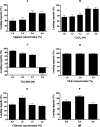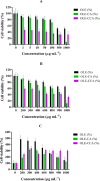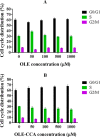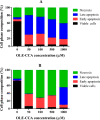Antiproliferative and Apoptotic Effects of Olive Leaf Extract Microcapsules on MCF-7 and A549 Cancer Cells
- PMID: 37599941
- PMCID: PMC10433482
- DOI: 10.1021/acsomega.3c01493
Antiproliferative and Apoptotic Effects of Olive Leaf Extract Microcapsules on MCF-7 and A549 Cancer Cells
Abstract
Alginate microcapsules are a talented means for the delivery of broad curative biomacromolecules. In this study, we immobilized olive leaf extract (OLE) by calcium alginate (CA) and chitosan-coated CA (CCA) and characterized the OLE-loaded CA and CCA. The cytotoxic effect, the cell cycle arrest, and the apoptotic effect of OLE and its microcapsules were investigated against breast adenocarcinoma (MCF-7) and lung carcinoma (A549). As a result, the loading capacity of OLE-CA and OLE-CCA was found to be 80 and 99%, respectively, in optimal conditions. Also, OLE-CA and OLE-CCA were characterized by unique FTIR peaks and morphological display relative to the empty CCA microcapsules. The cytotoxicity analysis showed that the IC50 values of OLE-CA and OLE-CCA were determined to be 312 and 0.94 μg mL-1 against A549, respectively, whereas these were found to be 865.4 and 425.5 μg mL-1 for MCF-7 cells. On the other hand, the OLE microcapsules did not possess in any concentration of cytotoxic influence on the BEAS 2B healthy cell line. Also, the exposure of OLE-CCA to MCF-7 and A549 resulted in the arrest of more MCF-7 and A549 cells at the G0/G1 phase compared to the OLE. A549 and MCF-7 cells were predominantly found in the late apoptosis phase and necrosis phase, respectively. Optical microscopy images confirmed that OLE microcapsules were more effective against MCF-7 and A549 than free OLE. The present work suggested that the OLE microcapsules might be administered as nutrition supplements for cancer therapy.
© 2023 The Authors. Published by American Chemical Society.
Conflict of interest statement
The authors declare no competing financial interest.
Figures






References
-
- Corrie P. G. Cytotoxic Chemotherapy: Clinical Aspects. Medicine 2008, 36, 24–28. 10.1016/J.MPMED.2007.10.012. - DOI
LinkOut - more resources
Full Text Sources
Research Materials

